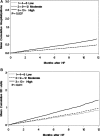Perceived Social Isolation and Outcomes in Patients With Heart Failure
- PMID: 29794038
- PMCID: PMC6015354
- DOI: 10.1161/JAHA.117.008069
Perceived Social Isolation and Outcomes in Patients With Heart Failure
Abstract
Background: Perceived social isolation has been shown to have a negative impact on health outcomes, particularly among older adults. However, these relationships have not been fully examined among patients with heart failure.
Methods and results: Residents from 11 southeast Minnesota counties with a first-ever International Classification of Diseases, Ninth Revision (ICD-9) code 428 for heart failure between January 1, 2013, and March 31, 2015 (N=3867), were prospectively surveyed to measure perceived social isolation. A total of 2003 patients returned the survey (response rate, 52%); 1681 patients completed all questions and were retained for analysis. Among these patients (53% men; mean age, 73 years), ≈19% (n=312) had moderate perceived social isolation and 6% (n=108) had high perceived social isolation. After adjustment, patients reporting moderate perceived social isolation did not have an increased risk of death, hospitalizations, or emergency department visits compared with patients reporting low perceived social isolation; however, patients reporting high perceived social isolation had >3.5 times increased risk of death (hazard ratio, 3.74; 95% confidence interval [CI], 1.82-7.70), 68% increased risk of hospitalization (hazard ratio, 1.68; 95% CI, 1.18-2.39), and 57% increased risk of emergency department visits (hazard ratio, 1.57; 95% CI, 1.09-2.27). Compared with patients who self-reported low perceived social isolation, patients reporting moderate perceived social isolation had a 16% increased risk of outpatient visits (rate ratio, 1.16; 95% CI, 1.03-1.31), whereas those reporting high perceived social isolation had a 26% increased risk (rate ratio, 1.26; 95% CI, 1.04-1.53).
Conclusions: In patients with heart failure, greater perceived social isolation is associated with an increased risk of death and healthcare use. Assessing perceived social isolation during the clinical encounter with a brief screening tool may help identify patients with heart failure at greater risk of poor outcomes.
Keywords: epidemiology; heart failure; outcome.
© 2018 The Authors, Mayo Clinic and Olmsted County Public Health Services. Published on behalf of the American Heart Association, Inc., by Wiley.
Figures
References
-
- Benjamin EJ, Blaha MJ, Chiuve SE, Cushman M, Das SR, Deo R, de Ferranti SD, Floyd J, Fornage M, Gillespie C, Isasi CR, Jimenez MC, Jordan LC, Judd SE, Lackland D, Lichtman JH, Lisabeth L, Liu S, Longenecker CT, Mackey RH, Matsushita K, Mozaffarian D, Mussolino ME, Nasir K, Neumar RW, Palaniappan L, Pandey DK, Thiagarajan RR, Reeves MJ, Ritchey M, Rodriguez CJ, Roth GA, Rosamond WD, Sasson C, Towfighi A, Tsao CW, Turner MB, Virani SS, Voeks JH, Willey JZ, Wilkins JT, Wu JH, Alger HM, Wong SS, Muntner P. Heart disease and stroke statistics—2017 update: a report from the American Heart Association. Circulation. 2017;135:e146–e603. - PMC - PubMed
-
- Heidenreich PA, Albert NM, Allen LA, Bluemke DA, Butler J, Fonarow GC, Ikonomidis JS, Khavjou O, Konstam MA, Maddox TM, Nichol G, Pham M, Pina IL, Trogdon JG. Forecasting the impact of heart failure in the United States: a policy statement from the American Heart Association. Circ Heart Fail. 2013;6:606–619. - PMC - PubMed
-
- Holt‐Lunstad J, Smith TB, Baker M, Harris T, Stephenson D. Loneliness and social isolation as risk factors for mortality: a meta‐analytic review. Perspect Psychol Sci. 2015;10:227–237. - PubMed
-
- Hawthorne G. Perceived social isolation in a community sample: its prevalence and correlates with aspects of peoples’ lives. Soc Psychiatry Psychiatr Epidemiol. 2008;43:140–150. - PubMed
Publication types
MeSH terms
Grants and funding
LinkOut - more resources
Full Text Sources
Other Literature Sources
Medical



